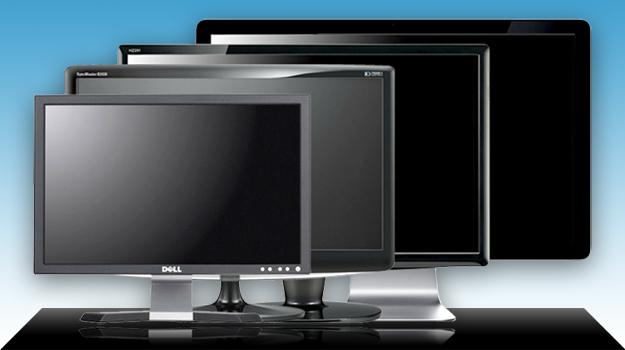Computer monitor buying guide
 Computer monitors often end up as an afterthought compared to the purchase of an actual computer. But considering how long you’ll spend staring into the screen reading email, browsing the Web and playing games, a monitor purchase deserves more thought. Wondering what to look for when you go shopping for your next display? Here’s a quick and primer to cut through the clutter and find the right display for you.
Computer monitors often end up as an afterthought compared to the purchase of an actual computer. But considering how long you’ll spend staring into the screen reading email, browsing the Web and playing games, a monitor purchase deserves more thought. Wondering what to look for when you go shopping for your next display? Here’s a quick and primer to cut through the clutter and find the right display for you.Size
Most buyers tend to figure out size before anything else, and for good reason: The monitor size you select will determine many of the other options available. The “right” size monitor for you will largely be determined by how much space you’re working with, what types of work you’ll do on it, and of course, your budget.
 While 19 inches used to be considered big for a CRT monitor, LCD displays have totally rebooted consumer expectations. Unless you’re constrained by space (setting it up on a narrow desk, under low shelves, in a hutch, etc.) try to go larger than 20 inches. Common screen sizes go all the way up to 30 inches, but keep in mind that resolution seldom goes past 1080p, so you’ll be stretching the same image bigger and bigger, which can degrade quality. Monitors up to about 23 or 24 inches typically offer plenty of room without looking grainy.
While 19 inches used to be considered big for a CRT monitor, LCD displays have totally rebooted consumer expectations. Unless you’re constrained by space (setting it up on a narrow desk, under low shelves, in a hutch, etc.) try to go larger than 20 inches. Common screen sizes go all the way up to 30 inches, but keep in mind that resolution seldom goes past 1080p, so you’ll be stretching the same image bigger and bigger, which can degrade quality. Monitors up to about 23 or 24 inches typically offer plenty of room without looking grainy.Resolution
Size may determine how big a picture looks to you, but resolution determines how much information you can actually fit on the screen. For productivity, more resolution means easier multitasking and more words in the same space. For movies and photos, more resolution means sharper appearance. In other words, more is always better.
The smallest desktop monitors come in resolutions down to 1366 x 768, but the vast majority offer 1920 x 1080 resolution, also known as 1080p. It’s popular for a reason: Besides offering plenty of room to spread out your windows, you’ll have exactly the right number of pixels for watching high-def content like Blu-ray movies and even HD YouTube content. Humongous 30-inch monitors sometimes offer 2560 x 1440 resolution, which you’ll want to keep an image that size from looking stretched. A number of less common resolutions like 1600 x 900 also exist, but we strongly recommend stretching your budget to hit 1080p, even if it means stepping down in size a bit.
Stands and mounting
Few consumer monitors offer stands that do anything other than tilt back and forth, so you may have to step up to a business monitor if you want it to telescope and up down or swivel without moving the base. For dual-display setups or workplaces, an aftermarket arm or wall mount sometimes makes sense, which typically requires VESA mounting capability — basically a standard pattern of screw holes in the back.
Connectivity
A single DVI input serves the needs of most consumers quite nicely, but HDMI is almost a prerequisite these days, and VGA never hurts in case you have to work with older equipment. Multiple inputs can also be useful if you plan to multitask with a monitor, like using it in a dorm room as both a TV and computer monitor. Many monitors also include perks like a built-in USB hubs and headphone jacks. Most monitors accept the same universal power cord, but new ultra-slim models often use an external power supply like a laptop, which can be one more piece to keep track of and another brick under your desk.
Other panel specs
Response time: A measure of how long it takes for a pixel to go from white to black and back. If your pixels can’t switch fast enough, you end with the type of “ghosting” that makes say, a football flying through the air look like it has a comet tail. Most monitors tend to average somewhere around 5ms, which most consumers find acceptable even for gaming.
Refresh rate: A measure of how many times your display can update the picture in a second, measured in hertz (Hz). A monitor with a faster refresh time, usually 120Hz, can often interpolate “in-between” frames to smooth motion, to make things like scrolling look more fluid. Standard monitors refresh at 60Hz.
Contrast ratio: A measure of the brightest white a monitor can produce to the blackest black it can produce, expressed as a ratio (ex. 1,000:1). Many manufacturers measure the “dynamic” contrast of a monitor, which is an artificially inflated number with little bearing on reality, diminishing its usefulness to buyers.
Viewing angle: A measure of the angles a monitor can effectively be viewed at, expressed in degrees (ex. 170°). Older LCDs typically had severe problems with viewing angles, but newer models seldom present a problem to seated viewers, making it less of an important factor.
Brightness: A measure of how much light a monitor can emit, expressed in candelas per square meter (cd/m2). Besides simply looking better, a brighter monitor is much easier to see in brightly lit surroundings. Ratings of 250 to 300 cd/m2 are common for many affordable monitors.
LED backlighting: Don’t let the marketing confuse you: LED monitors are simply LCD monitors that use an LED backlight. Besides using less power, LEDs allow manufacturers to make monitors slimmer, brighter, and without the warm-up time of traditional compact fluorescent (CFL) backlights.
Gloss or matte: Manufacturers tend to downplay the difference of an LCD screen’s coating, but depending on lighting conditions, it can make a huge difference. Glossy screen coatings tend to enhance contrast for a more vibrant look, but also reflect their surroundings more readily when powered down or displaying dark images. Matte monitors displays tend to look duller, but work better under challenging lighting conditions, like across from large windows.
TN or IPS: Twisted nematic (TN) panels are used in most inexpensive monitors, because they’re cheap, power efficient, and have quick refresh rates. In-plane switching (IPS) panels are used in higher end monitors because they offer better color reproduction and viewing angles.
No comments:
Post a Comment